Navigating the Market for Used Leather Chesterfield Sofas
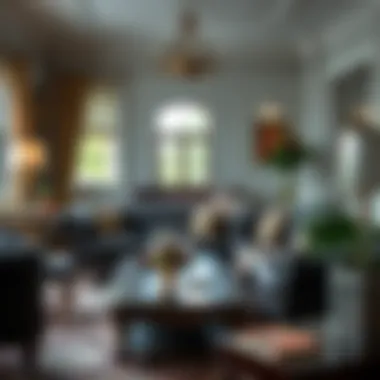

Intro
In today’s diverse landscape of interior design, the appeal of vintage pieces has taken center stage. Among the most captivating of these treasures is the used leather Chesterfield sofa. Its timeless elegance and rich history make it a favorite among homeowners and designers alike. This guide is aimed at exploring not just the aesthetic charm but also the practical aspects of acquiring these sofas—from market insights to maintenance tips—to ensure that anyone can make a well-informed purchase, enhancing their living spaces with a touch of classic sophistication.
Furniture Design Trends
As we navigate the current trends in furniture design, it's crucial to examine how the Chesterfield sofa fits into the broader tapestry of contemporary styles and themes.
Current Styles and Themes
The Chesterfield has evolved from a staple of Victorian-era decor to a versatile piece that seamlessly integrates into various modern aesthetics. Whether one leans towards the streamlined approach of minimalism or the rich layering of bohemian styles, the Chesterfield adapts beautifully. In many homes today, it serves as a statement piece, one where its classic tufted design contrasts with sleek lines and neutral furnishings. Moreover, it’s not limited to formal living rooms; you’ll find it making an appearance in eclectic office settings and cozy reading nooks alike.
Color Palettes and Materials
When considering colors, the versatility of leather is a major advantage. While traditional deep browns and blacks remain perennial favorites, lighter shades such as taupe and even white are gaining popularity. Additionally, upholstery options now include bold colors or even patterned leather, reflecting personal style and the homeowner's personality. Beyond leather, consider fabrics like velvet or linen for cushions that complement the sofa. Mixing materials can help create a rich texture in any space, making it lively and inviting.
"Choosing the right colors and materials can redefine the atmosphere of a room, turning a simple space into a warm and welcoming sanctuary."
Practical Furniture Tips
Investing in a used leather Chesterfield sofa is more than a purchase; it’s an entry into a legacy of craftsmanship. However, understanding how to evaluate these pieces can enhance your experience.
How to Choose the Right Size
Before you fall in love with a specific sofa, measure your space carefully. A Chesterfield sofa can be imposing due to its design, so ensuring it fits harmoniously with the surrounding furniture is vital. Generally, it’s best to leave about 18 inches between the sofa and other pieces for comfort and accessibility. Consider how you intend to use the space—whether for entertaining or relaxation—as this will also dictate size selections.
Maintenance and Care for Longevity
Leather sofas, when taken care of, can be incredibly durable. Here are crucial maintenance tips:
- Condition Regularly: Use a leather conditioner every six months to keep the leather supple.
- Clean Spills Promptly: Wipe off any spills right away to prevent stains—use a soft damp cloth for best results.
- Avoid Direct Sunlight: Too much exposure can lead to fading over time, so placing your sofa away from direct sunlight is beneficial.
- Vacuum Often: Dust and dirt can accumulate, affecting both appearance and lifespan.
By integrating these practices into your routine, you’ll not only preserve the beauty of your vintage Chesterfield sofa but also ensure it remains a cherished element in your home for years to come.
For more information on vintage furniture trends, you might find helpful articles at Wikipedia or Britannica. For practical tips and community advice, forums like Reddit and pages on platforms like Facebook can serve as valuable resources.
Understanding Chesterfield Sofas
When delving into the world of vintage furniture, Chesterfield sofas stand out as icons of elegance and comfort. These rich, leather-clad pieces exude a timeless appeal that transcends generations. Understanding Chesterfield sofas is not merely about recognizing their aesthetic allure, but also appreciating the craftsmanship, historical context, and cultural weight they carry. This article aims to explore these elements, which in turn enrich your decision-making process should you be considering a used Chesterfield sofa for your space.
Historical Background
The origin of Chesterfield sofas dates back to the 18th century, specifically linked to Lord Phillip Stanhope, the fourth Earl of Chesterfield. Legend has it that he commissioned a unique sofa design that would allow for elegant posture while promoting social interaction. While some stories might be lost to time, the essential idea remains: Chesterfields were made for style and comfort in public and private settings alike. Over the years, they evolved from being a status symbol for the upper-class décor to a staple in both modern and traditional homes.
Exploring the historical background of Chesterfield sofas provides insight into how they have remained relevant over the centuries. Even today, they symbolize a blend of luxury and functionality, appealing to homeowners who cherish history while valuing design.
Design Features
Chesterfield sofas are renowned for several distinctive design features that make them instantly recognizable. For starters, the signature deep button-tufting not only adds a plush appearance but also enhances durability. The scroll arms, often as high as the back, reflect a graceful and inviting silhouette, making them perfect focal points in living rooms and studies alike.
In terms of materials, traditionally, they feature rich, full-grain leather, which ages beautifully and develops a unique patina over time. Style variations exist, incorporating various colors and finishes, but the classic browns and blacks still dominate the scene, evoking a sense of nostalgia while remaining versatile for contemporary spaces.
Consequently, the design of Chesterfield sofas is more than just eye candy; it's practical and sophisticated. Their robust construction ensures longevity, proving they are more than a fleeting fashion, but rather a sturdy investment suitable for a multitude of interiors.
Cultural Significance
Chesterfield sofas have grown beyond their functional and aesthetic qualities; they embody cultural significance that resonates with various audience groups. In British culture, they are revered as symbols of comfort and hospitality, often found in pubs and lounge areas, inviting patrons to gather and bond. Meanwhile, in literature and film, they frequently serve as settings for key character interactions, underscoring their importance in storytelling.
Moreover, in recent years, the rise of vintage and sustainable living has elevated the Chesterfield’s status. Consumers today are increasingly aware of their furniture choices, favoring pieces that not only boost aesthetic appeal but also reflect sustainable practices. This aligns perfectly with Chesterfield sofas traditions of durability and quality craftsmanship, making them potentially more desirable in a market that celebrates history and sustainability.
In summation, grasping the full picture of Chesterfield sofas involves a deeper look into their history, design, and cultural relevance, which ultimately guides you in making a more informed decision when considering these remarkable pieces for your home.
Characteristics of Leather
When delving into the world of leather Chesterfield sofas, understanding the characteristics of leather is paramount. Not only does it influence the aesthetic appeal of your living space, but it also determines the longevity and comfort of your investment. Because these sofas can be a center piece, knowing what goes into the materials helps inform your decision-making process.
Types of Leather Used
Leather comes in a variety of types, each offering different qualities and looks. When it comes to Chesterfield sofas, you might encounter:
- Full-Grain Leather: This type retains the natural grain. It’s durable and develops a unique patina over time, giving it a robust yet elegant aura.
- Top-Grain Leather: A step down from full-grain, it is sanded and refinished to remove imperfections. It’s easier to clean and less pricey, making it popular in homes.
- Bonded Leather: Made from leftover scraps and fibers, this type is economical but tends to be less durable. While it looks good, it might not stand the test of time as well as its higher-quality counterparts.
The choice of leather can profoundly impact how the Chesterfield sofa ages, how comfortable it remains, and its overall value.
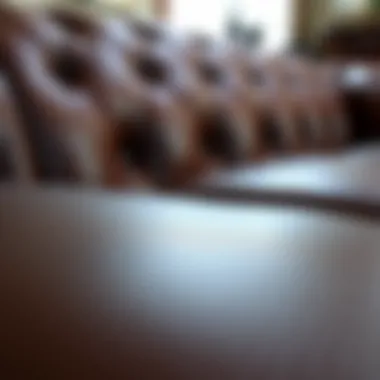
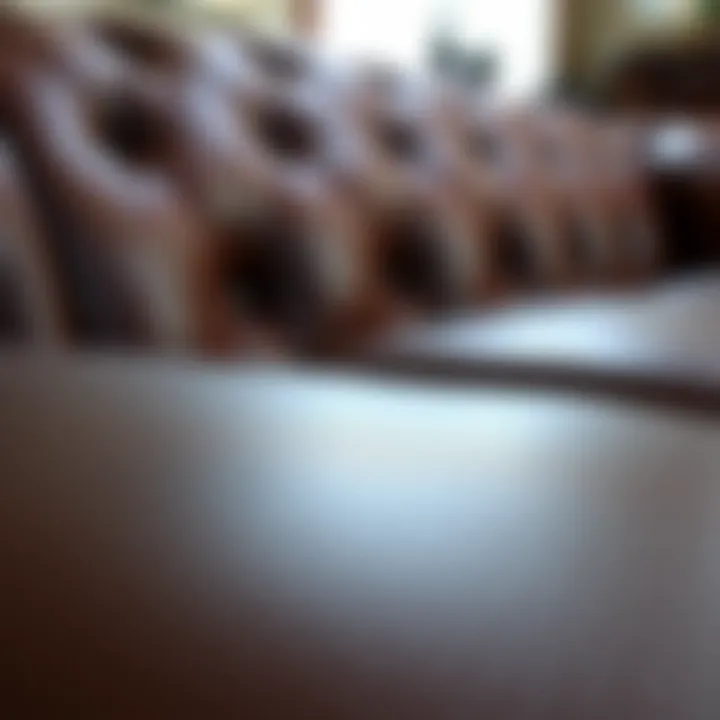
Durability and Aging of Leather
Leather is synonymous with durability, but this appraises based on the type and the care it receives. Full-grain leather can last decades, potentially outliving you when cared for properly. It naturally breathes and ages gracefully, developing character. Conversely, other types of leather can show wear more quickly.
When considering aging, here are a few points to remember:
- Natural Patina: Good leather will gain a patina that adds a unique touch.
- Flexibility and Softness: Leather might start rigid but becomes softer over time with usage.
- Signs of Aging: Minor creases or fading can enhance charm but large cracks or peeling indicate poor quality or neglect.
Proper maintenance can extend the life and beauty of leather furniture, making it an excellent long-term investment.
Maintenance Tips for Leather Sofas
Maintaining your leather Chesterfield sofa isn’t rocket science, but it certainly requires a bit of attention. Here are some handy tips:
- Regular Cleaning: Use a soft cloth to wipe down surfaces. You don’t need fancy cleaners; a mixture of mild soap and water can do wonders.
- Conditioning: At least twice a year, apply a leather conditioner to keep the material supple and prevent cracking. This is especially essential for older pieces.
- Avoid Direct Sunlight: Sunlight can dry and fade leather over time, so positioning your sofa out of direct sun is wise.
- Address Spills Quickly: Accidents happen. If something spills, blot it with a clean cloth immediately rather than scrubbing it, which can worsen the damage.
Let’s not forget, with the right care, you can keep your Chesterfield looking as sharp as the day you brought it home.
In summary: Understanding the characteristics of leather is essential. Make decisions informed by the type, durability, and maintenance of leather to ensure your Chesterfield sofa remains a beloved piece for years.
Market Trends in Used Furniture
The market for used furniture has seen significant shifts in recent years, driven by changing consumer preferences and increasing awareness about sustainability. One might consider this trend as a reflection of a broader cultural movement towards valuing history, craftsmanship, and the unique character that vintage items bring to modern homes. We've all heard the phrase "one man's trash is another man's treasure," and it certainly rings true in the realm of second-hand furniture.
Identifying these trends in used furniture not only enhances the consumer’s purchasing experience but also reinforces the economic and environmental impacts of their choices. As people become more discerning about where and how their furniture is sourced, it becomes imperative for anyone interested in used leather Chesterfield sofas to stay knowledgeable about these trends.
Popularity of Vintage Furniture
The resurgence in popularity of vintage furniture is hard to overlook. Chesterfield sofas, known for their timeless design, have found themselves at the heart of this revival. The appeal lies not only in their aesthetic charm but also in a deep-seated appreciation for craftsmanship. Consumers seek pieces with stories, with soul – items that whisper tales of the past.
Characteristics that contribute to the rising appeal of vintage furniture include:
- Unique Styles: Unlike modern mass-produced pieces, vintage furniture offers a rich variety of designs and materials. Whether it’s a deep green velvet Chesterfield or a distressed leather variant, each piece stands out.
- Durability: Older furniture is often constructed with high-quality materials, built to withstand the test of time. Consumers are increasingly wary of disposable culture and prefer items that last.
- Sustainability: As environmental concerns grow, many homeowners opt for used furniture as an eco-friendly choice. It allows them to reduce waste and carbon footprints while adding character to their spaces.
The rise of social media platforms and online marketplaces has further fueled this trend, allowing enthusiasts to showcase their finds and create communities centered around vintage aesthetics. Sites such as Etsy, Facebook Marketplace, and various local buy-and-sell groups are bustling with listings, inviting both collectors and casual shoppers alike.
Pricing Dynamics of Used Sofas
When it comes to pricing, the dynamics of used Chesterfield sofas can be quite intricate. The perceived value of these sofas fluctuates based on several factors. Pricing isn't merely about the initial purchase but involves a deeper understanding of market conditions, item condition, and buyer sentiment.
Key elements influencing the pricing of used sofas include:
- Condition: The state of a sofa significantly impacts its value. A well-preserved Chesterfield, with minimal scratches and a rich patina, will generally command a higher price than one that shows signs of excessive wear.
- Rarity and Demand: Certain styles or colors may be more sought after than others, escalating their prices. For instance, a classic brown leather Chesterfield may remain popular, while a less common shade or design might be worth a premium due to its uniqueness.
- Market Trends: Factors such as shifts in consumer preferences toward minimalism or environmental consciousness can affect prices. Sofas that match current trends can fetch more; likewise, a dip in popularity will typically lead to lower prices.
The market for used Chesterfield sofas is not just a reflection of aesthetic choices; it mirrors broader economic and social currents, guiding buyer behavior and pricing throughout the landscape.
Understanding the economics of used furniture serves not only as a guide for making informed purchases but also underscores the broader implications of a growing trend towards mindful consumption. Armed with the right knowledge, prospective buyers can navigate this intricate market with confidence.
Where to Find Used Leather Chesterfield Sofas
The search for a used leather Chesterfield sofa can often feel like searching for a needle in a haystack. Many consumers appreciate these stylish furniture pieces not just for their aesthetic appeal, but for the stories they carry and the craftsmanship they represent. Knowing where to look can save time, reduce stress, and lead to discovering some genuine treasures. Whether you’re a homeowner seeking to enrich your living room with vintage charm or a designer looking for standout pieces, understanding where to find these sofas is crucial to making the right purchase. Here’s a breakdown of some prime sources:
Local Antique Shops
Local antique shops are often a hidden goldmine for unique, quality furniture. As they carry a curated collection of vintage items, these shops enable you to physically inspect the Chesterfield sofa before committing to a purchase. When you’re in a shop, you can touch the leather, inspect the stitching, and assess the overall condition directly, which is a significant advantage over online shopping.
Here are several factors to consider when visiting local antique shops:
- Knowledgeable Staff: Many shopkeepers are passionate about antiques and can provide insights into the history of the sofa or the craftsmanship involved.
- Bargaining Opportunities: Unlike fixed prices in big retailers, antique shops often allow room for negotiation, presenting a chance for deals.
- Quirky Finds: You might find a Chesterfield with an unusual color or pattern that you wouldn’t come across in more mainstream environments.
Online Marketplaces
In today’s digital age, online marketplaces like eBay, Craigslist, or Facebook Marketplace have surged in popularity. They allow shoppers to explore a broader range of options, often at competitive prices. However, buying a used sofa online comes with its own set of considerations:
- Wider Reach: You can browse listings from all over the country. This opens the doors to options that may not be available in your local area.
- Comparative Shopping: You can easily compare prices and styles across multiple listings, allowing you to make more informed decisions.
- User Reviews: Look for sellers with good ratings. Previous buyers’ experiences can often inform you about the seller’s reliability and the quality of the item.
While the convenience of online shopping is appealing, it's critical to verify the seller's credibility and the sofa's condition through clear, detailed photos and descriptions.
Auction Houses
Auction houses present a distinctive avenue for sourcing unique Chesterfield sofas. Attending an auction can be thrilling, and it's often an opportunity to purchase high-quality items at potentially lower prices than market value. Here's what you should keep in mind when considering this route:
- Competitive Bidding: If you find a sofa you really love, be prepared to compete with other bidders. It’s wise to set a budget beforehand to avoid overextending.
- Expert Appraisals: Many high-end auctions provide expert descriptions and history on the items, which can provide essential context about the piece you’re eyeing.
- Unique Items: Auctions often feature rare and unique Chesterfields that you simply won’t find in regular stores.
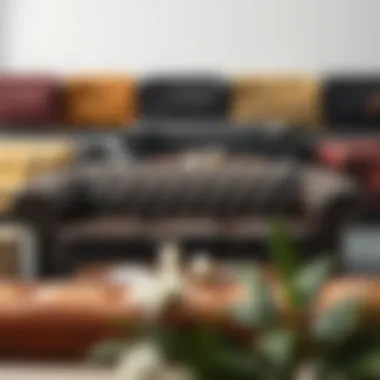
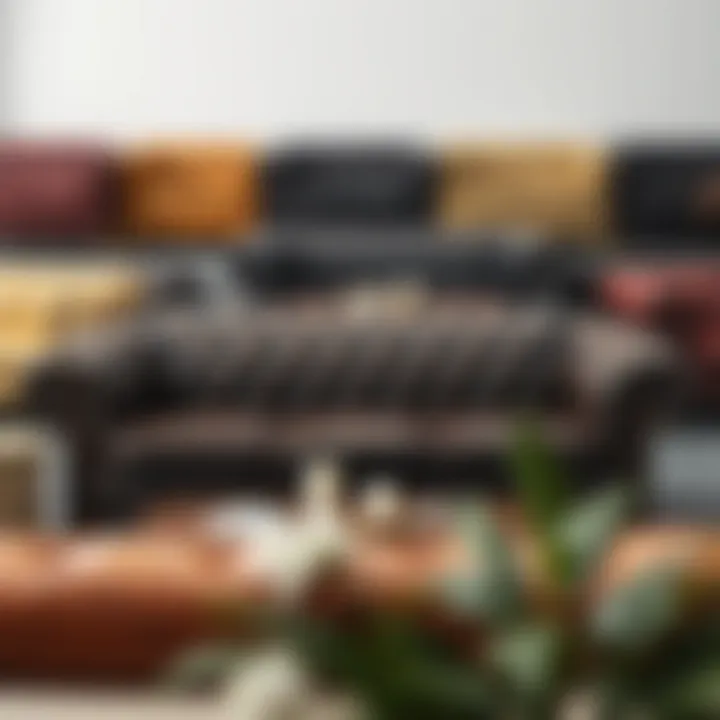
"The thrill of the hunt for the perfect Chesterfield sofa makes the reward all the more satisfying."
By being informed about the various places to seek out these vintage treasures, you can make a more educated decision that enhances your space with a timeless piece.
Evaluating Quality in Used Sofas
When diving into the world of used leather Chesterfield sofas, understanding how to evaluate quality is not just important; it's like having a key to a treasure chest full of vintage charm. The way these sofas have stood the test of time speaks volumes about their craftsmanship and the materials used. You want to ensure that whatever piece you bring home is not only aesthetically pleasing but also durable enough to last through the years.
The significance of evaluating quality in used sofas goes beyond mere appearance. It encompasses factors like comfort, longevity, and the overall value of your investment. A well-chosen Chesterfield can elevate your living space, while also facilitating the wise use of resources by opting for second-hand goods.
Signs of Wear and Tear
Worn-out features can tell you a lot about a sofa’s past life. When you are considering a used leather Chesterfield, be on the lookout for specific signs of wear. Not every mark or scratch is a deal-breaker, but some can hint at deeper problems.
- Cracks and Fissures: Check the leather for cracks, especially around the seams. This can indicate the leather has dried out and may require costly repairs.
- Sagging: Sit on the sofa. Does it sink too low, or are springs squeaking? A well-maintained Chesterfield should feel sturdy without unexpected dips.
- Staining: Look for discolorations or stains. Some stains can be cleaned, but others might indicate hidden damage.
Make sure to inspect the cushions and seating areas thoroughly. If they feel lumpy or misshapen, it’s a sign that they have lost their form and support over time.
Checking for Authenticity
Authenticity in the market for used leather Chesterfield sofas often matters immensely. A genuine Chesterfield boasts specific characteristics that distinguish it from its replicas. If you're shelling out good money, you want to be sure you're investing in the real McCoy.
- Labels and Tags: Many authentic Chesterfields come with a label from the manufacturer. Look for information that confirms the sofa's origins. A lack of tagging can indicate inauthenticity.
- Construction Quality: Inspect stitching closely. Authentic Chesterfields often showcase tight, even stitching without loose or fraying threads. Loose or messy stitches can hint at inferior quality.
- Materials Used: Genuine models often use high-grade leather and solid wood frames. If it feels light or looks of poor quality, you might be facing a replica rather than an authentic piece.
Consider also engaging with local experts or relying on established retailers that can provide documentation of authenticity. This adds an extra layer of assurance when handpicking your sofa.
Condition Assessment
A thorough condition assessment of your potential Chesterfield sofa is paramount. To make an informed decision, you must evaluate more than just the obvious features. This offers a window into the true state of the piece and indicates how much love and care it has received.
- Frame Integrity: Start with the frame's condition. Use your hands to feel for any creaking, wobbles, or soft spots. A strong frame ensures longevity.
- Cushion Quality: Assess the cushions by pressing them and checking for their responsiveness. Do they bounce back nicely or stay depressed? This is crucial for comfort.
- Leather Quality: Beyond wear and tear, the overall quality of the leather should reflect its age and care. It should still feel supple and maintain its natural luster.
- Odor Assessment: Smell the sofa. A musty fungal or moldy smell can indicate deeper issues that may require professional cleaning or even replacement of certain elements.
By conducting a meticulous assessment, you're not merely buying a piece of furniture. You're investing in a lifestyle choice that could enhance the aesthetic and functional value of your home for years to come.
When shopping for used leather Chesterfield sofas, remember: the sofa should feel like a piece of history, not a laundry list of regrets.
In summary, properly evaluating the quality of used leather Chesterfield sofas involves a careful inspection of visible signs of wear, authentication checks, and a thorough condition assessment. This ensures not only reliable furniture that enhances your space but also a mindful purchase contributing to the sustainable use of resources.
Styling with Chesterfield Sofas
When it comes to the world of interior design, the role of Chesterfield sofas extends beyond mere functionality. Their distinct character presents opportunities for creativity and expression in styling a space. Integrating a used leather Chesterfield sofa into your home can breathe life into a room, combining elegance, history, and comfort.
Complementary Furniture Arrangements
A Chesterfield sofa is often the centerpiece of a room, demanding attention for its unique design. When arranging complementary furniture, think of maintaining a balance that highlights the sofa while ensuring the space feels cohesive.
- Pairing with Chairs: Flanking the sofa with armchairs can create an inviting conversational area. Look for accent chairs with curves or similar leather texture to create harmony without distracting from the Chesterfield.
- Coffee Tables: A low-profile coffee table can complement the sofa’s height. Choose materials that contrast or match the leather, such as glass for a sleek look or wood for warmth.
- Rug Selection: Consider a large area rug beneath the sofa to define the space. A neutral palette can ground the setup, while a bold print can add flair, tying together various elements across the room.
Arranging furniture around a Chesterfield involves considering flow and interaction. Avoid overcrowding the area to encourage movement while also promoting conversation.
Choosing Color Palettes
Color plays a pivotal role in ensuring that a Chesterfield sofa integrates seamlessly into your existing decor.
- Neutral Tones: Classic leather colors like deep brown or black allow for flexibility, ensuring that the sofa can adapt to a wide range of color schemes. Neutrals create an elegant foundation and allow for colorful accents.
- Accent Colors: Use cushions and throws to introduce pops of color. Jewel tones—rich greens or deep reds—can elevate the vintage charm of the Chesterfield.
- Monochromatic Scheme: For a modern take, consider a monochromatic look where the walls and furniture share similar tones. This can draw attention to the textures rather than competing colors.
Selecting an effective color palette not only enhances the Chesterfield's beauty, but it also brings out its craftsmanship and age, essentially telling the story of the piece.
Accessorizing the Space
Accessorizing around a Chesterfield sofa can further enhance its striking presence. Accessories bridge the gap between furnishings and the overall ambiance of your space.
- Artwork and Decor: Hang art pieces or photographs that resonate with the colors and theme of the sofa. Large statement pieces can set the mood, while smaller frames can offer a gallery vibe on nearby walls.
- Lighting Choices: A well-placed floor lamp or stylish table lamps can elevate the Chesterfield’s charm during evening hours. Look for fixtures that have metallic finishes or vintage styling to complement the sofa’s classic appeal.
- Plant Life: Incorporate some greenery, be it tall floor plants or small succulents on side tables, to introduce natural elements. Plants can provide contrast against the leather and soften the overall look, enhancing the room's warmth.
Ultimately, styling a room around a Chesterfield sofa is about creating a narrative. It’s about blending old-world charm with modern aesthetics, enabling each piece to tell its own story while contributing to the overall atmosphere.
The Chesterfield is not just furniture; it's a statement of lasting style and elegance that sets the tone for your entire space.
Consider these points when styling your Chesterfield sofa, and it will not only enhance your home’s decor but also become a beloved focal point for years to come.
Long-Term Investment Considerations
When it comes to home furnishing, investing in quality pieces can be a balancing act between aesthetics and practicality. The allure of used leather Chesterfield sofas lies not just in their charm, but in various long-term benefits they offer. Understanding these considerations can decisively shape your purchase choices and future satisfaction with your investment.
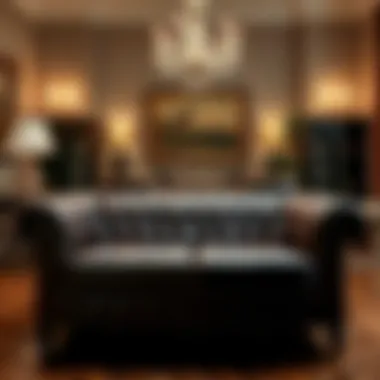
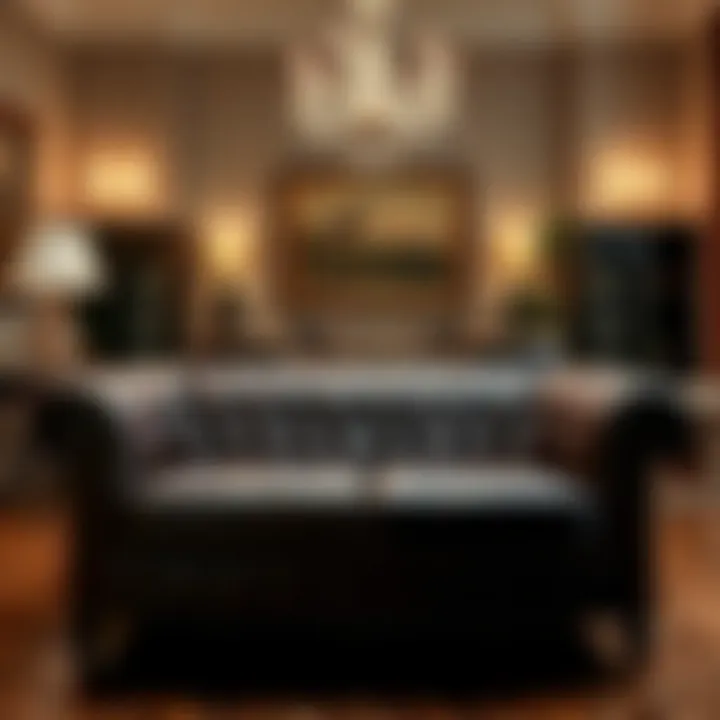
Value Retention Over Time
Used Chesterfield sofas maintain a remarkable ability to hold their value. Unlike many contemporary furniture options that depreciate rapidly, quality vintage pieces can actually appreciate as they age. Factors influencing this include:
- Craftsmanship: The timeless design and superior build quality of Chesterfields contribute significantly to their desirability.
- Leather Aging: Well-cared-for leather tends to develop a rich, inviting patina over time, enhancing the sofa's visual appeal and value.
- Market Demand: As vintage designs continue to make a mark in today’s interior trends, the demand for authentic Chesterfields remains stable, often making them a worthy investment.
“Investing in a Chesterfield is not just buying a sofa; it’s securing a piece of history.”
In light of these factors, homeowners seeking a blend of style and long-term investment may find leather Chesterfields appealing for their enduring worth.
Potential for Restoration
Another compelling aspect of these sofas is their potential for restoration. Used leather Chesterfields often carry minor wear and tear, yet this hardly signifies obsolescence. In fact, many of these imperfections can be transformed into stunning attributes through careful restoration. Some key considerations include:
- Upcycling: With a little creativity, worn sofas can be reimagined to fit modern decor. Reupholstering or adding custom cushions can breathe new life into an older piece.
- Professional Services: There are a range of skilled craftsmen and restoration professionals specializing in antique furniture. Their expertise can significantly elevate a Chesterfield, returning it to its former glory—adding both comfort and style.
- DIY Potential: For the hands-on enthusiast, minor repairs or touch-ups, such as conditioning leather or replacing buttons, can be great weekend projects. With some effort, a homeowner can create a truly unique sofa that marries vintage attractiveness with personal flair.
In summary, the long-term investment considerations for used leather Chesterfield sofas extend beyond simple aesthetics. They offer factors like value retention and restoration potential that can greatly enhance both the functionality and style of your living space, proving that investing wisely can yield dividends beyond the financial aspect.
Sustainability in Furniture Choices
In today’s world, where environmental concerns are at the forefront, the concept of sustainability in furniture choices is more relevant than ever. This holds particularly true when we discuss used leather Chesterfield sofas. The furniture market is beginning to understand that reusing and restoring furniture can have a significant impact on both the environment and consumer behavior. Choosing second-hand furniture, like a Chesterfield, reduces demand for new products, ultimately leading to less waste that ends up in landfills.
Not only does this recycling of materials help to conserve resources, but it often results in higher quality and more durable items that hold historical value. Each used Chesterfield carries a story, reflecting the craftsmanship of its time and often exhibiting a level of mechanical integrity that today's furniture sometimes lacks. By considering sustainability when purchasing, consumers help preserve the legacy of classic designs while enjoying pieces that have developed their own character through time.
There are several aspects to weigh when thinking about sustainability:
- Material longevity: Leather is known for its durability and can often last for decades, if not centuries. This longevity means that a used Chesterfield can provide years of service without needing to be replaced.
- Environmental impact: Producing new furniture usually requires extensive resources. From tree cutting to leather tanning processes, each step consumes energy and echoes through ecosystems. By taking a used item off the market, the consumer actively participates in reducing this impact.
- Energy consumption: The energy required to manufacture new sofas is substantial. By choosing to buy used, consumers contribute to energy savings and reduce their own carbon footprint.
When discussing sustainability, we should also acknowledge how consumers can influence brands and manufacturers to adopt more eco-friendly practices. As demand for sustainable furniture rises, many brands are rethinking their sourcing, production, and disposal processes. Though the eco-friendly movement is finding fertile ground in furniture design, purchasing used items like leather Chesterfields already aligns perfectly with sustainable practices.
Eco-Friendly Aspects of Used Furniture
Used furniture represents an incredible opportunity to embrace eco-friendliness while decorating your home. Here’s how:
- Recycled materials: Used furniture often includes materials that have already been processed, meaning the owner contributes less to the demand for new raw materials.
- Less landfill waste: By purchasing an already existing sofa, you’re helping to circumvent the cycle of production and waste. You’re not only saving a piece of furniture from a landfill but also enhancing your home’s charm with history.
- Support local economies: Purchasing from local shops, thrift stores, or estate sales helps stimulate the local economy, allowing communities to benefit from sustainable practices.
- Unique finds: Each piece has its own narrative, adding character and personality to the living space. Unlike mass-produced items, these unique attributes often lead to a more aesthetically pleasing environment.
Engaging in sustainable furniture choices, particularly by opting for used leather Chesterfield sofas, highlights a commitment to both style and environmental responsibility. The beauty of these sofas doesn’t vary with their age; in fact, most would argue that they become more exquisite with time and care. With thoughtful purchasing decisions, homeowners and interior designers alike can create spaces that not only look good but are good for the planet.
Challenges of Buying Used Sofas
Buying used leather Chesterfield sofas can feel like navigating a minefield. It's easy to get swept away by the allure of vintage charm, but several challenges lurk beneath the surface. Recognizing these issues before making a purchase is vital for ensuring you don't end up with a sofa that's more trouble than it's worth. This section will shed light on common pitfalls and offer practical advice for overcoming them.
Finding Reliable Vendors
One of the first hurdles in the quest for a second-hand Chesterfield is finding trustworthy vendors. Not all sellers are created equal, and this is especially true in the world of used furniture. Navigating local antique shops, online marketplaces, or even auction houses requires a discerning eye.
When searching for reliable vendors, consider the following criteria:
- Reputation: Research sellers' backgrounds and read online reviews. Platforms like Reddit often have discussions about local vendors, offering insights from previous buyers.
- Expertise: Ensure the vendor specializes in vintage or antique furniture. A knowledgeable seller can provide insights about the sofa's history and authenticity.
- Return Policy: Look for vendors who offer a return policy, just in case the sofa doesn't meet your expectations after it's delivered.
Asking questions is key. Don't hesitate to inquire about the sofa’s history, condition, and care. A reputable vendor will be transparent.
Dealing with Sizing Issues
Sizing is another critical consideration when buying a used Chesterfield. These sofas can be grand and imposing, typically meant for spacious living rooms. But what if you live in an apartment? You wouldn't want to end up with a sofa that swallows your entire lounge.
To avoid sizing mishaps, take these steps:
- Measure Your Space: Measure the intended area for the sofa, including doorways and hallways the sofa must pass through.
- Know the Specs: Familiarize yourself with the typical dimensions of Chesterfield sofas. They can vary, so get the details from your vendor or look online for common measurements.
- Picture It: Use painter’s tape to outline where the sofa would sit in your space. This visual guide can help you gauge if the sofa is a fit or if it’ll overwhelm the room.
Making a poor choice in size can lead to regret, so it’s best to measure twice and cut once.
Transport and Delivery Concerns
Lastly, transport and delivery issues are crucial when investing in a used Chesterfield. These pieces aren't just pieces of furniture; they are heavy, often awkwardly shaped, and made of leather, which can be delicate. A little carelessness during transport can result in scratches or damages.
Consider these points:
- Delivery Services: If the vendor offers delivery, inquire about their methods. Some companies specialize in transporting furniture, and hiring a professional can save you a lot of headache.
- DIY Transport: If you’re thinking of going it alone, ensure you have the appropriate vehicle and manpower. Sometimes, gathering a few friends can save money, but you must be careful.
- Weather Awareness: If you're in a region where the weather can be unpredictable, plan accordingly. Rain or extreme cold can damage leather if the sofa isn't properly covered during transport.
The End
When it comes to purchasing a used leather Chesterfield sofa, the conclusion we draw is more than just a closing thought. It serves as a multifaceted beacon for the journey one undertakes while exploring the market. Choosing a Chesterfield isn’t merely about selecting a piece of furniture. It’s about embracing history, craftsmanship, and the undeniable charm that accompanies vintage decor. With the increasing popularity of sustainable living, opting for a pre-owned Chesterfield is a pragmatic choice that also speaks to eco-consciousness.
In this article, we've covered essential elements that contribute to making a wise purchase. The historical context enriches the meaning behind the sofa itself, going beyond its aesthetics. It reveals the craftsmanship and cultural significance, grounding your decisions in a broader narrative.
Benefits of Using the Insights From This Article
- Enhanced Knowledge: Understanding how to evaluate the quality of used leather helps you identify red flags and find true treasure amid the options.
- Market Savvy: Insight into current trends and pricing equips you with the information necessary to negotiate effectively. Knowing when to buy and what features to look for can save money and time.
- Aesthetic Harmony: This article emphasizes the importance of style and comfort, encouraging readers to envision how a Chesterfield piece can fit into their existing home decor.
- Informed Choices: With detailed tips, from maintenance to vendor recommendations, you’ll navigate the used furniture market with confidence.



